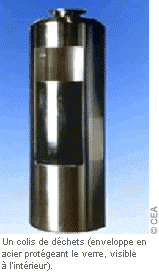Le coin des amatheurs de sciences version 2 
The sections of the site : The site  FORUM
FORUM  The space
The space  The genetics
The genetics  Medicine
Medicine  Physics
Physics  Tintin and science
Tintin and science  Ecology - Nuclear energy
Ecology - Nuclear energy  Mysteries of the history
Mysteries of the history  Humour
Humour  Diverse
Diverse
Le coin des amatheurs de sciences version 2 
The sections of the site : The site  FORUM
FORUM  The space
The space  The genetics
The genetics  Medicine
Medicine  Physics
Physics  Tintin and science
Tintin and science  Ecology - Nuclear energy
Ecology - Nuclear energy  Mysteries of the history
Mysteries of the history  Humour
Humour  Diverse
Diverse
| Ecology - Nuclear energy |
|---|
| Tchernobyl |
| The truth on the wind mills |
| Nuclear waste |
| The protocol of Kyoto |
| The bomb H and the Nobel |
| Dongtan |
| After oil |
What could we make with the nuclear waste which encumbers us ? The researchers of the CEA are thinking about that. The French government had to take a decision in 2006, but in July 2005, the ministers François Loos (Industry) and François Goulard (Research) have put back the date to 2015.
However, a first report has been published. Because if waste of the type A (weak lifespan, 90% of the French products) and B (approximately 10%) worry little, those of type C (high activity and long life) worry much. Some like americium, iodine 129 or cesium 135 can remain several hundred millenia.
The first idea is of sorting the nuclear waste for better treating them. It's very difficult because certain, the actinides (type C), are very similar, but some waste could then be the subject of new reactions to become less toxic.
 The second track is the storage. It is increasingly sure (certain containers can remain intact to 99,9% after 10 000 years of contact with water) but very cumbersome. But especially, where to store them ? Because a good place of storage must be a sure place, very protected from the natural disasters, but easily accessible : a law of 1991 requires that the containers be able to be recovered by our successors, if they found a solution to recycle waste. An other important question : how could we indicate to futur generations the nature of waste and the hazardness of diging ? (you can reed about that an excellent article of Science et Vie number 1094, November 2008)
The second track is the storage. It is increasingly sure (certain containers can remain intact to 99,9% after 10 000 years of contact with water) but very cumbersome. But especially, where to store them ? Because a good place of storage must be a sure place, very protected from the natural disasters, but easily accessible : a law of 1991 requires that the containers be able to be recovered by our successors, if they found a solution to recycle waste. An other important question : how could we indicate to futur generations the nature of waste and the hazardness of diging ? (you can reed about that an excellent article of Science et Vie number 1094, November 2008)
But during this time, the power stations provide new waste and one recovers those of the United States...
The most original idea is certainly that of Alexander Meshik. This researcher studies Oklo, a kind of natural nuclear engine discovered in Gabon in 1972. He does not function but functioned two billion years ago, a reaction of fission occurring there. There are thus over there radioactive products, more precisely xenon and krypton 85. Naturally preserved. The products are trapped in aluminophosphate : a mixture of lanthanum, cerium, strontium and calcium.
According to infoscience.fr and Sciences et avenir